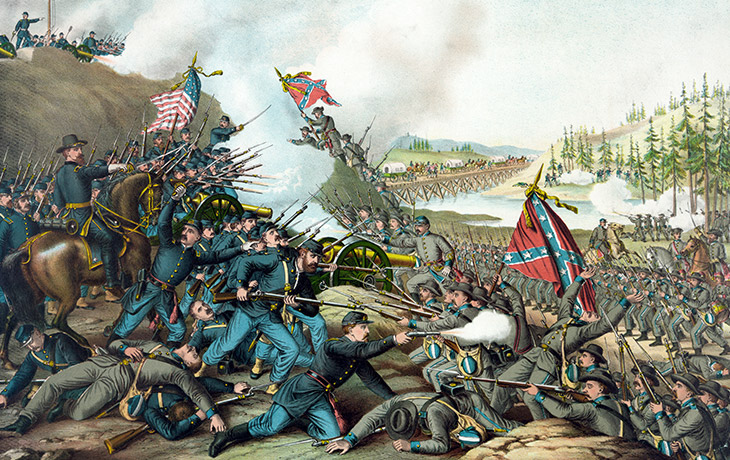“Civil War 2.0” is a topic that comes up with depressing regularity in my social media feeds, both because it’s a real concern in some quarters and because it’s a source of sweet sweet clickbait traffic for mainstream media outlets.
I have read most of the clickbait and some of the serious work on this topic over the years, so here’s a brief selection of Civil War 2.0 links that’s actually worth spending time with.
American War, by Omar El Akkad
If you want to get a feel for the gritty texture of day-to-day life in a war-torn North America, Omar El Akkad’s American War is the best thing going. The refugee camps, suicide bombings, deaths from preventable diseases, and other features of life in the cracks between constantly warring factions will make you realize that no matter how bad things seem right now, they can always get a whole lot worse.
I’m not sure how plausible the setup of the book is: a civil war over fossil fuels. But you shouldn’t read it to try to understand why a second Civil War could break out — rather, read it to get a sense of what life would be like during a violent domestic conflict.
Akkad is a veteran war reporter who has covered America’s overseas conflicts and seen first-hand what it’s like for ordinary people in violent conflict zones. And he has an eye for small details that make the world of an American Civil War 2.0 seem completely real.
The book got glowing reviews in the New York Times, Globe and Mail, and other outlets when it was released. I first heard about it in an NPR segment.
It Could Happen Here, by Robert Evans
The podcast It Could Happen Here started making the rounds of prepper Facebook groups earlier in the year, and for a while it worked its way up into the top 50 podcasts online.
I listened to it and enjoyed it, though some will be turned off by the author’s open sympathies for Antifa, which really surface in later episodes. But whatever your politics, it’s a worthwhile series of thought exercises that attempt to lay out the how and why of various aspects of a coming American crack-up.
The author and voice of the podcast, Robert Evans, is a journalist who covered the Iraqi Civil War, so like El Akkad he has spent some time in the trenches and has an eye for subtle detail. So I recommend it to anyone who wants to think through this issue carefully, whether for preparedness reasons or just to get a sense of the space of possible future outcomes for the country.
“The Origins of the American Military Coup of 2037,” by ML Cavanaugh
Published in 2017, this fictional future memoir of the events leading up to an American military coup in 2037 depicts a world that’s a kind of Red Dawn meets 1984, with a dash of Outbreak thrown in.
The essay opens with a Chinese invasion of the West Coast, an invasion that’s brought on by America’s weakened state thanks to partisan infighting and the collapse of our democracy. I would actually watch that movie, but then the essay turns swiftly to depicting a gradual breakdown in civilian/military relations, as the American military got progressively more involved in politics, which lead to an eventual coup.
So the piece is not so much about a second Civil War as it is about a domestic political conflict that results in a military takeover of the country before the Cold Civil War ever actually goes fully hot.
Cavanaugh is West Point Fellow and a scholar of civilian/military relations, and this essay is aimed at those scholarly conversations and not so much at the general public. So it can be a bit of a snoozer.
The essay also has a clear political slant — Cavanaugh is mainly worried about a right-wing military coup, and it shows. So depending on where you fall on whether this idea is ridiculous or not, you’ll either like it or hate it.
“The Origins of the America Military Coup of 2012,” Charles J Dunlap Jr.
ML Cavanaugh’s 2017 essay is a clear homage to a much earlier piece [PDF] from 1992, “The Origins of the America Military Coup of 2012,” by one CJ Dunlap.
The Dunlap essay is a widely-cited classic that addresses many of the same themes as Cavanaugh’s, but from a different period and political angle. Here is part of the core of the essay:
Still, that doesn’t completely explain why in 2012 the military leadership would succumb to a coup. To answer that question fully requires examination of what was happening to the officer corps as the military drew down in the 1980s and 1990s. Ever since large peacetime military establishments became permanent features after World War II, the great leveler of the officer corps was the constant influx of officers from the Reserve Officers Training Corps program. The product of diverse colleges and universities throughout the United States, these officers were a vital source of liberalism in the military services. By the late 1980s and early 1990s, however, that was changing. Force reductions decreased the number of ROTC graduates the services accepted.
Although General Powell called ROTC “vital to democracy,” 62 ROTC programs were closed in 1991 and another 350 were considered for closure. The numbers of officers produced by the service academies also fell, but at a significantly slower pace. Consequently, the proportion of academy graduates in the officer corps climbed. Academy graduates, along with graduates of such military schools as the Citadel, Virginia Military Institute, and Norwich University, tended to feel a greater homogeneity of outlook than, say, the pool of ROTC graduates at large, with the result that as the proportion of such graduates grew, diversity of outlook overall diminished to some degree.
Moreover, the ROTC officers that did remain increasingly came from a narrower range of schools. Focusing on the military’s policy to exclude homosexuals from service, advocates of “political correctness” succeeded in driving ROTC from the campuses of some of our best universities. In many instances they also prevailed in barring military recruiters from campus. Little thought was given the long-term consequences of limiting the pool from which our military leadership was drawn. The result was a much more uniformly oriented military elite whose outlook was progressively conservative.
You can see where he’s going with this — the US armed forces eventually became so separate from civilian elites, and so accustomed to intervening in foreign civilian life via humanitarian aid missions and nation building, that they eventually turned on a dysfunctional US polity and started doing all that stuff right here at home.
As with the 2017 essay that’s based on it, it’s not strictly a “Civil War 2.0” scenario, but there are so many adjacencies and it’s so important that it’s worth a read.
Also, if you scroll down to the comments on the ML Cavanaugh essay, you can see that Dunlap really doesn’t like Cavanaugh’s attempted reboot of his work.
Assessing Revolutionary And Insurgent Strategies (ARIS) Studies
If you really want to get into the weeds of formally thinking through insurgencies and revolutions in modern countries, then US Special Forces’ ARIS page is the start of the rabbit hole.
I’d scroll all the way to the bottom and start with the Unconventional Warfare Pocket Guide [PDF], which will introduce you to how the US military thinks about insurgencies, revolutions, and other intra-state conflicts.
You can then work your way back up the page through various case studies, where you can learn all kinds of things about the nuts and bolts of guerilla warfare and active resistance.
Various media articles and blogs
There have been a number of solid, recent efforts at thinking about a second Civil War from a mix of mainstream sources and bloggers. Here’s a handful of them that I liked:
Game Theory on the “Second Civil War”, BJ Campbell. You may have read BJ’s excellent “The Surprisingly Solid Mathematical Case of the Tin Foil Hat Gun Prepper,” so this is sort of like that, but for this Civil War 2.0 topic. Even if you just skim it, there are tons of links in it to other good writing on this subject.
What a new U.S. civil war might look like, Foreign Policy. The author writes, I think correctly, that “the shape of future homeland conflicts will be asymmetrical, distributed, and heterogeneous. A contemporary homeland conflict would likely self-compose with numerous dynamic factions organized by digital tools around ideological and affinity networks.” Go read the rest.
Culture of Fear: Miriam Carey’s Tragedy, and Our Own, Rick Perlstein. This is not actually a Civil War 2.0 piece, but rather it’s a look back just how much domestic political violence there was in the 1970’s. Perlstein writes, “But there was terrorism then, nearly every month—eighty-nine bombings attributed by the FBI to terrorism in 1975, culminating in that awful LaGuardia bomb; and a veritable wave in the winter and spring 1976, much of it around the trial of Patty Hearst; of an FBI office in Berkeley, Standard Oil of California headquarters in San Francisco.” Read the essay, and then imagine this level of conflict in the modern world of social media.
America’s Next Civil War, Stephen Marche. Published about a year ago in The Walrus, this is one of the higher-quality attempts to game out a Second Civil War. Interviews with experts, polling data, informed speculation — the piece has it all.
Is America Headed for a New Kind of Civil War?, Robin Wright. This lengthy essay is similar to the Marche one listed above, but it’s earlier.
Stop worrying about a second civil war, Jason Phillips. A Civil War historian makes the optimistic case in the Washington Post.

